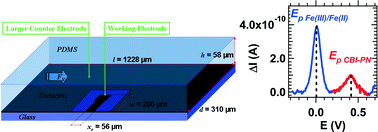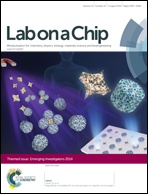Improved electrochemical detection of a transthyretin synthetic peptide in the nanomolar range with a two-electrode system integrated in a glass/PDMS microchip†
Abstract
An alternative to a three-electrode set-up for electrochemical detection and analysis in microfluidic chips is described here. The design of the electrochemical sensor consists of the surface of the glass substrate covered with a PDMS block which bears the microfluidic channels. A band microelectrode which acts as a working electrode surrounded by a large counter electrode is obtained at the micrometric level to propose a simple and efficient sensing area for on-a-chip analysis. The counter-electrode with a surface area about 22-fold greater than the working-microelectrode can also be considered as a pseudo reference since its current density is low and thus limits the potential variations around the rest potential. To this purpose, the [Fe(III)(CN)6]3−/[Fe(II)(CN)6]4− redox couple was used in order to set a reference potential at 0 V since both electrodes were platinum. The electrochemical microchip performance was characterized using differential pulse voltammetric (DPV) detection and quantification of the optically multi-labelled transthyretin synthetic peptide mimicking a tryptic fragment of interest for the diagnosis of familial transthyretin amyloidosis (ATTR). The limit of detection of the peptide by the working microelectrode was 25 nM, a value 100-fold lower than the one reported with conventional capillary electrophoresis coupled with laser-induced fluorescence under the same analytical conditions.


 Please wait while we load your content...
Please wait while we load your content...